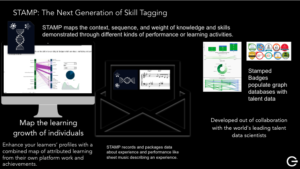Standardized Talent Asset Mapping Protocol (STAMP): The Need for Semantic Interoperability in Talent Data Integration
Abstract: In today’s data-driven world, the ability to harness the full potential of talent data is a strategic imperative for organizations. However, the integration of talent data from diverse sources remains a formidable challenge. This article delves into the pressing need for a method like STAMP (Standardized Talent Asset Mapping Protocol) to combine talent data comprehensively, explaining why skill tags, when not contextualized, fall short in providing meaning. By leveraging graph databases powered by Linked Data files (JSON-LDs), STAMP ensures the true mapping of talent from experiences, offering a solution for semantic interoperability through crosswalks or “Rosetta stones.” Furthermore, we make a compelling case for the incorporation of STAMP principles into Credential Transparency Description Language (CTDL).
The Complex Landscape of Talent Data Integration
Talent data comes in various forms and from diverse sources, making its integration a complex task. Organizations collect talent-related information from job applicants, employee records, learning management systems, and more. While the data is invaluable, the challenge lies in making sense of it all.
Skill Tags: A Limited Perspective
One common approach to manage talent data is the use of skill tags. These are keywords or labels assigned to individuals based on their skills and competencies. While skill tags serve as a convenient way to categorize talent, they fall short in providing meaningful insights. This is primarily because skill tags lack essential contextual information, such as proficiency levels, time relevance, or associations with specific experiences.
The Role of Context in Talent Data
Understanding talent data requires context. Imagine two individuals with the skill tag “Java Programming.” Without additional context, it’s impossible to determine the depth of their expertise, when they acquired the skill, or the projects they’ve worked on. This lack of context hampers talent decision-making and workforce planning.
Enter STAMP: A Semantic Solution
STAMP, or Standardized Talent Asset Mapping Protocol, offers a groundbreaking solution to the challenges of talent data integration. At its core, STAMP recognizes the importance of context in talent mapping. It operates on the principle that talent can only be fully understood when mapped from experiences.
Graph Databases and Linked Data (JSON-LD): STAMP leverages graph databases powered by Linked Data files (JSON-LDs) to create a comprehensive talent mapping system. JSON-LD is a format for structuring data to provide context and meaning. In the context of talent data, JSON-LDs allow for the representation of skills, competencies, and experiences in a structured, linked format.
Mapping Talent from Experiences: STAMP’s approach begins with the mapping of talent from experiences. It links skills and competencies to specific projects, tasks, or learning activities. This contextual mapping captures the richness of an individual’s capabilities, enabling organizations to make more informed talent decisions.
Semantic Interoperability through Crosswalks: A key feature of STAMP is its emphasis on semantic interoperability. In the absence of a standardized approach, integrating talent data from different sources can be chaotic. STAMP introduces the concept of crosswalks or “Rosetta stones.” These are reference points within JSON-LDs that act as keys to interpret the meaning of data. They facilitate seamless integration by ensuring that skill tags and competencies are universally understood.
The Case for STAMP in Credential Transparency Description Language (CTDL)
The principles of STAMP have far-reaching implications for the world of credentials. As credentialing systems become more diverse and dynamic, the need for a standardized approach to describing credentials is paramount. Credential Transparency Description Language (CTDL) can greatly benefit from the incorporation of STAMP principles.
Contextual Credential Descriptions: By integrating STAMP principles into CTDL, credential descriptions can become more contextual. Instead of simply listing skills, CTDL can capture how those skills were acquired, the level of expertise, and their relevance over time. This richer context empowers employers, educational institutions, and learners to make informed decisions.
Enhanced Semantic Interoperability: CTDL with STAMP principles ensures enhanced semantic interoperability. Credentials described using this approach can be seamlessly integrated into various systems and platforms, allowing for better matching of credentials with job requirements or educational pathways.
Conclusion: A Semantic Future for Talent Data Integration
In the era of data-driven decision-making, organizations must harness the full potential of their talent data. STAMP offers a revolutionary approach by emphasizing the importance of context in talent mapping. Leveraging graph databases and Linked Data files (JSON-LDs), STAMP ensures that talent can be fully understood when mapped from experiences. Furthermore, its principles are ripe for incorporation into credentialing systems, providing richer, more contextual descriptions of credentials. As organizations strive for semantic interoperability in talent data integration, STAMP emerges as a beacon of innovation and efficiency.





